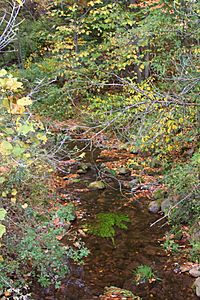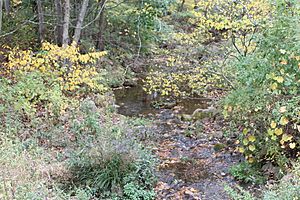Mill Creek (Roaring Creek tributary) facts for kids
Quick facts for kids Mill Creek |
|
|---|---|

Mill Creek in its upper reaches
|
|
| Physical characteristics | |
| Main source | Catawissa Mountain in Roaring Creek Township, Columbia County, Pennsylvania 1,380 to 1,400 feet (420 to 430 m) |
| River mouth | Roaring Creek in Locust Township, Columbia County, Pennsylvania 846 ft (258 m) 40°53′37″N 76°22′20″W / 40.8935°N 76.3721°W |
| Length | 3.1 mi (5.0 km) |
| Basin features | |
| Progression | Roaring Creek → Susquehanna River → Chesapeake Bay |
| Basin size | 4.98 sq mi (12.9 km2) |
Mill Creek is a small stream located in Columbia County, Pennsylvania. It flows into Roaring Creek. The creek is about 3.1 miles (5.0 kilometers) long. It runs through two areas: Roaring Creek Township and Locust Township.
The area of land that drains into Mill Creek is about 4.98 square miles (12.9 square kilometers). This creek is special because it's known as a High-Quality Coldwater Fishery. This means its water is very clean and cold, perfect for certain fish. It's also a Class A Wild Trout Waters, which means it's a great place for wild trout to live and grow naturally. Many tiny water creatures, called macroinvertebrates, also call Mill Creek home. The creek got its name from an old mill that used to be nearby.
Contents
Where Does Mill Creek Flow?
Mill Creek starts high up on Catawissa Mountain in Roaring Creek Township. It flows generally southwest, winding its way through the landscape. Along its path, it picks up water from a smaller, unnamed stream.
The creek then flows past the small community of Kulp. Here, it crosses State Route 2003. It continues to flow through a valley for about a mile. After this, Mill Creek enters Locust Township. It then leaves the valley and flows across a flat area. Finally, it meets and joins Roaring Creek. Mill Creek connects with Roaring Creek about 15 miles (24 kilometers) upstream from where Roaring Creek ends.
What Streams Join Mill Creek?
Mill Creek has two smaller streams that flow into it. These streams are not named.
How Clean and Cold is Mill Creek's Water?
The water in Mill Creek is quite clean and cold. The amount of alkalinity in the water is 11 milligrams per liter. The pH of the creek is 6.6, which is slightly acidic. The water is also considered soft, with a total hardness of 20 milligrams per liter. However, farming activities in the area do have some impact on the creek.
On a specific day in June 2004, the air temperature near the creek was 24.0 degrees Celsius (75.2 degrees Fahrenheit). At the same time, the water temperature was 14.8 degrees Celsius (58.6 degrees Fahrenheit). The water's specific conductivity was 49 micromhos, which tells us how well electricity can pass through the water.
In 2007, experts checked the health of Mill Creek. They gave it a score of 19 out of 28, which is a good score. This means the creek provides a healthy home for its wildlife. Mill Creek is known as an "infertile" stream, meaning it doesn't have a lot of nutrients. But it does have very cold water, which is good for certain fish species.
What Does Mill Creek Look Like?
Mill Creek is a relatively small stream. Near where it joins Roaring Creek, the elevation is about 846 feet (258 meters) above sea level. Where the creek begins, its elevation is much higher, between 1380 and 1400 feet (421 and 427 meters).
The creek is about 4.2 feet (1.3 meters) wide. It flows downhill quite steeply, dropping about 29.8 meters for every kilometer it travels. Mill Creek also has some deep spots, which are excellent places for fish and other creatures to live.
The Land Around Mill Creek
The entire area of land that drains into Mill Creek is called its watershed. This watershed covers about 4.98 square miles (12.9 square kilometers). The end of the creek is in the eastern part of Locust Township.
Most of the land along Mill Creek, and its smaller unnamed streams, is covered by forests. Mill Creek is the smallest stream that flows into Roaring Creek. A large part of Mill Creek's length, about 48 percent, is within 100 meters (330 feet) of a road. This means it's fairly close to human activity. However, it can be hard to reach some parts of the creek because all of it is on private land that is not open to the public. In the year 2000, there were about 18 people living in each square kilometer of the watershed.
The headwaters, or beginning, of Mill Creek are close to the Pennsylvania State Game Lands Number 58.
History and Name of Mill Creek
Mill Creek gets its name from an old mill called the Mowrey Mill. This mill was built way back in 1820 by a person named Abner Hampton.
In 2007, volunteers from a group called the Roaring Creek Valley Conservation Association checked on the creek's health. Interestingly, Mill Creek was the only stream in the Roaring Creek area that had not been studied by the Pennsylvania Fish and Boat Commission before a big survey in 2009.
Animals Living in Mill Creek
Mill Creek is a very important home for fish and other water creatures. The Pennsylvania Fish and Boat Commission considers it to be Class A Wild Trout Waters. This means it's one of the best places for wild trout to live and reproduce naturally. The Pennsylvania Department of Environmental Protection also calls it a High-Quality Coldwater Fishery, highlighting its excellent water quality for cold-water fish.
Both brook trout and brown trout live in Mill Creek. In total, five different kinds of fish have been found here:
- Brook trout
- Brown trout
- Eastern blacknose dace
- White suckers
- Creek chub
Experts suggest that trout should not be stocked (added from fish farms) into Mill Creek. This is because the wild trout population is doing very well on its own.
Trout Population in Mill Creek
Mill Creek has a healthy population of wild trout. The total amount of wild brown trout living in the creek is about 48.28 kilograms per hectare. For wild brook trout, it's about 23.92 kilograms per hectare.
It's estimated that there are about 110 brown trout per kilometer that are longer than 7 inches (18 centimeters). For brook trout, there are about 83 per kilometer of that length. Overall, there are an estimated 561 brown trout and 423 brook trout longer than 7 inches (18 centimeters) in the entire creek. The biggest brook trout found are about 11 inches (28 centimeters) long, and the largest brown trout are about 12 inches (30 centimeters) long. Mill Creek is special because it's the only stream in the Roaring Creek area where wild brook trout are commonly found.
Tiny Creatures in Mill Creek
A wide variety of tiny water creatures, called macroinvertebrates, live in Mill Creek. There are 24 different types of these creatures found here. Some common types include Hydropsychidae, Nigronia, and Philopotamidae.
Other types that are less common but still present include Ephemerellidae, Gomphidae, Heptageniidae, Limnephilidae, Perlidae, Perlodidae, Pteronarcyidae, and Sialidae. Some macroinvertebrate types are rare in the creek, such as Baetidae, Cambaridae, Dytiscidae, Ephemeridae, Isonychiidae, and Leptophlebiidae. The presence of so many different types of macroinvertebrates shows that Mill Creek is a healthy ecosystem.
Images for kids



